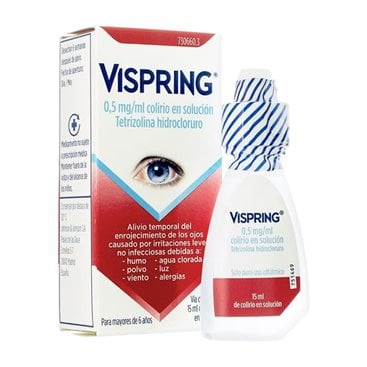Vispring 0.5 Mg/Ml Eye Drops in Solution 1 Bottle 15 Ml
Vispring (Visine) is indicated for the temporary symptomatic relief of mild conjunctival congestion in adults and children over 6 years of age due to: smoke, wind, chlorinated water, light and other irritating agents.
Vispring (Visine) is indicated for the temporary symptomatic relief of mild conjunctival congestion in adults and children over 6 years of age due to: smoke, wind, chlorinated water, light and other irritating agents.
Vispring (Known as Visine): Effective Relief for Eye Irritation
Vispring, marketed as Visine in English-speaking countries, is an ophthalmic solution designed to relieve red and irritated eyes caused by minor eye allergies, dust, or pollution. With a fast-acting vasoconstrictor mechanism, it reduces redness and provides relief for up to 6 hours.
What Is Vispring (Visine) Used For?
This solution is ideal for the temporary relief of:
- Red eyes caused by minor irritations or conjunctivitis.
- Eye itching and excessive tearing associated with allergies or environmental irritants.
- Eye irritation due to non-specific or allergic conjunctivitis.
The active ingredient, tetrahydrozoline, works by narrowing the blood vessels in the eyes, quickly reducing redness and irritation.
How to Use Vispring (Visine)
To ensure proper application and optimal results, follow these instructions:
- Adults and children over 6 years: Instill 1-2 drops into each eye 2-3 times daily as needed, up to a maximum of 4 times per day.
- Children aged 2-6 years: Use only under strict medical supervision.
- Children under 2 years: Use is contraindicated.
Steps for correct application:
- Wash your hands thoroughly.
- Tilt your head back and gently pull down the lower eyelid to create a small pocket.
- Bring the dropper close to your eye, ensuring it doesn’t touch the surface of your eye or any other surface.
- Apply the prescribed number of drops into the pocket and blink a few times to distribute the liquid evenly.
- Close your eyes gently for 2 minutes or press the nasolacrimal duct to minimize systemic absorption.
If using another eye medication, wait at least 10 minutes between applications. Ointments should always be applied last.
Can I Use Vispring (Visine) with Contact Lenses?
Yes, but it’s important to remove soft contact lenses before applying the solution. Wait at least 15 minutes before reinserting your lenses. This precaution is due to the presence of benzalkonium chloride, which may affect soft lenses.
Important Precautions
Before using this product, consider the following:
- Do not exceed 7 consecutive days of use, as prolonged usage may lead to rebound congestion or dry eyes.
- Discontinue use and consult a doctor if redness or irritation persists beyond 48 hours.
- Avoid use if you have glaucoma, high blood pressure, diabetes, or thyroid disorders without medical advice.
Contraindications
- Allergy to any component of the product.
- Glaucoma or a predisposition to it.
- Children under 2 years old.
Side Effects
Vispring (Visine) is generally safe when used as directed. However, some users may experience:
- Mild eye irritation or burning sensation.
- Temporary blurred vision.
- Rebound redness or dryness with excessive use.
Rarely, systemic effects such as headaches, palpitations, or nausea may occur due to absorption into the bloodstream. If side effects persist or worsen, stop using the product and consult a healthcare provider.
Why Choose Vispring (Visine)?
- Fast relief: Quickly reduces redness and irritation within minutes.
- Long-lasting effects: Provides relief for up to 6 hours.
- Convenient format: The 15 ml bottle is easy to use and carry.
Whether caused by allergies, environmental irritants, or non-specific conjunctivitis, this solution offers reliable relief for red and irritated eyes.
Where to Buy Vispring (Visine)?
You can purchase this product online at competitive prices. Available for delivery in many regions, including English-speaking markets, where it is sold under the name Visine. Enjoy the convenience of fast shipping and the assurance of an original product.
Leaflet Vispring 0.5 Mg/Ml Eye Drops in Solution 1 Bottle 15 Ml




